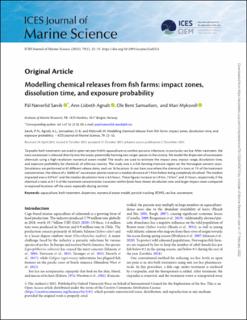| dc.description.abstract | Tarpaulin bath treatments are used in open net-pen finfish aquaculture to combat parasitic infections, in particular sea lice. After treatment, the toxic wastewater is released directly into the ocean, potentially harming non-target species in the vicinity. We model the dispersion of wastewater chemicals using a high-resolution numerical ocean model. The results are used to estimate the impact area, impact range, dissolution time, and exposure probability for chemicals of arbitrary toxicity. The study area is a fish-farming intensive region on the Norwegian western coast. Simulations are performed at 61 different release dates, each on 16 locations. In our base case where the chemical is toxic at 1% of the treatment concentration, the release of a 16000 m³ wastewater plume traverses a median distance of 1.9 km before being completely dissolved. The median impacted area is 0.9 km² and the median dissolution time is 6.8 hours. These figures increase to 5.9 km, 7.0 km², and 21 hours, respectively, if the chemical is toxic at 0.1 % of the treatment concentration. Locations within fjords have slower dissolution rates and larger impact zones compared to exposed locations off the coast, especially during summer. | en_US |
